

Don't Ask What The Internet Can Do For Art, Ask What Art Can Do For The Internet. Henry David Thoreau. Thoreau's books, articles, essays, journals, and poetry amount to more than 20 volumes.
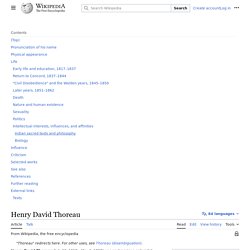
Among his lasting contributions are his writings on natural history and philosophy, in which he anticipated the methods and findings of ecology and environmental history, two sources of modern-day environmentalism. His literary style interweaves close observation of nature, personal experience, pointed rhetoric, symbolic meanings, and historical lore, while displaying a poetic sensibility, philosophical austerity, and Yankee attention to practical detail.[3] He was also deeply interested in the idea of survival in the face of hostile elements, historical change, and natural decay; at the same time he advocated abandoning waste and illusion in order to discover life's true essential needs.[3] Pronunciation of his name[edit] Physical appearance[edit] Thoreau had a distinctive appearance, with a nose that he called "my most prominent feature.
Jacques Cousteau. Jacques-Yves Cousteau AC (French: [ʒak iv kusto]; commonly known in English as Jacques Cousteau; 11 June 1910 – 25 June 1997)[1] was a French naval officer, explorer, conservationist, filmmaker, innovator, scientist, photographer, author and researcher who studied the sea and all forms of life in water.
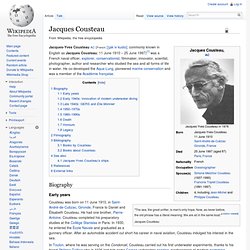
He co-developed the Aqua-Lung, pioneered marine conservation and was a member of the Académie française. Biography "The sea, the great unifier, is man's only hope. Abraham Maslow. Abraham Harold Maslow (/ˈmæzloʊ/[citation needed]; April 1, 1908 – June 8, 1970) was an American psychologist who was best known for creating Maslow's hierarchy of needs, a theory of psychological health predicated on fulfilling innate human needs in priority, culminating in self-actualization.[2] Maslow was a psychology professor at Brandeis University, Brooklyn College, New School for Social Research and Columbia University.

He stressed the importance of focusing on the positive qualities in people, as opposed to treating them as a "bag of symptoms. "[3] A Review of General Psychology survey, published in 2002, ranked Maslow as the tenth most cited psychologist of the 20th century.[4] Carl Sagan. Carl Edward Sagan (/ˈseɪɡən/; November 9, 1934 – December 20, 1996) was an American astronomer, cosmologist, astrophysicist, astrobiologist, author, science popularizer, and science communicator in astronomy and other natural sciences.
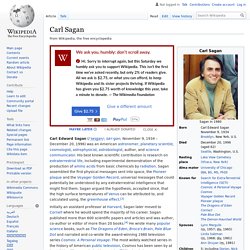
He is best known for his work as a science popularizer and communicator. His best known scientific contribution is research on extraterrestrial life, including experimental demonstration of the production of amino acids from basic chemicals by radiation. Sagan assembled the first physical messages sent into space: the Pioneer plaque and the Voyager Golden Record, universal messages that could potentially be understood by any extraterrestrial intelligence that might find them. Sagan argued the now accepted hypothesis that the high surface temperatures of Venus can be attributed to and calculated using the greenhouse effect.[1] Antoine de Saint-Exupéry. French writer and aviator Saint-Exupéry spent 28 months in America, during which he wrote three of his most important works, then joined the Free French Air Force in North Africa—although he was far past the maximum age for such pilots and in declining health.
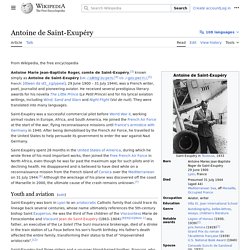
He disappeared and is believed to have died while on a reconnaissance mission from Corsica over the Mediterranean on 31 July 1944. Prior to the war, Saint-Exupéry had achieved fame in France as an aviator. His literary works posthumously boosted his stature to national hero status in France,[7][8] including The Little Prince which has been translated into 300 languages.[9] He earned further widespread recognition with international translations of his other works. Youth and aviation[edit] Coat of arms of the de Saint-Exupéry family since the 18th century.
Birthplace of Saint-Exupéry in the Presqu'île section of Lyon, on the street now named after him, in blue at lower left. Bob Marley. Robert Nesta "Bob" Marley, OM (6 February 1945 – 11 May 1981) was a Jamaican reggae singer, song writer, musician, and guitarist who achieved international fame and acclaim.[1][2] Starting out in 1963 with the group The Wailers, he forged a distinctive songwriting and vocal style that would later resonate with audiences worldwide.

The Wailers would go on to release some of the earliest reggae records with producer Lee Scratch Perry.[3] After the Wailers disbanded in 1974,[4] Marley pursued a solo career that culminated in the release of the album Exodus in 1977, which established his worldwide reputation and produced his status as one of the world's best-selling artists of all time, with sales of more than 75 million records.[5][6] He was a committed Rastafari who infused his music with a sense of spirituality.[7] Early life and career Marley and Neville Livingston (later known as Bunny Wailer) had been childhood friends in Nine Mile. Bob Marley and the Wailers 1962–1972: Early years Notes. Mahatma Gandhi. Mohandas Karamchand Gandhi (pronounced [ˈmoːɦənd̪aːs ˈkərəmtʃənd̪ ˈɡaːnd̪ʱi] ( ); 2 October 1869 – 30 January 1948) was the preeminent leader of Indian nationalism in British-ruled India.
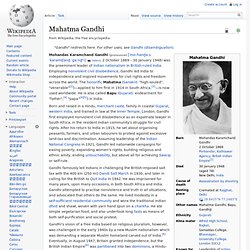
Employing nonviolent civil disobedience, Gandhi led India to independence and inspired movements for civil rights and freedom across the world. The honorific Mahatma (Sanskrit: "high-souled", "venerable"[2])—applied to him first in 1914 in South Africa,[3]—is now used worldwide. He is also called Bapu (Gujarati: endearment for "father",[4] "papa"[4][5]) in India. Theodore Roosevelt. 26th president of the United States Theodore Roosevelt Jr. ( ROH-zə-velt;[b] October 27, 1858 – January 6, 1919) was an American statesman, politician, conservationist, naturalist, and writer who served as the 26th president of the United States from 1901 to 1909.
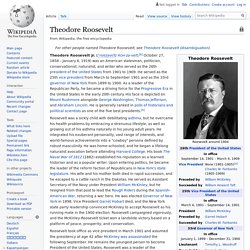
He served as the 25th vice president from March to September 1901 and as the 33rd governor of New York from 1899 to 1900. As a leader of the Republican Party, he became a driving force for the Progressive Era in the United States in the early 20th century. His face is depicted on Mount Rushmore alongside George Washington, Thomas Jefferson, and Abraham Lincoln. Edward Abbey. American author and essayist (1927-1989)
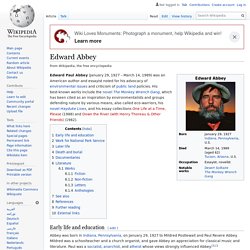
John Muir. In his later life, Muir devoted most of his time to the preservation of the Western forests.
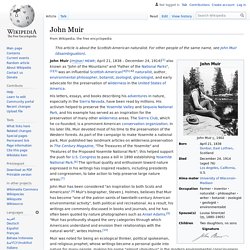
He petitioned the U.S. Congress for the National Park bill that was passed in 1890, establishing Yosemite National Park. The spiritual quality and enthusiasm toward nature expressed in his writings has inspired readers, including presidents and congressmen, to take action to help preserve large nature areas.[3] Today Muir is referred to as the "Father of the National Parks"[4] and the National Park Service has produced a short documentary about his life.[5] John Muir has been considered "an inspiration to both Scots and Americans".[6] Muir's biographer, Steven J.
Holmes, believes that Muir has become "one of the patron saints of twentieth-century American environmental activity," both political and recreational. Alan Watts. Terence McKenna. Buckminster Fuller. Richard Buckminster "Bucky" Fuller (/ˈfʊlər/; July 12, 1895 – July 1, 1983)[1] was an American architect, systems theorist, author, designer, inventor, and futurist.
Buckminster Fuller was the second president of Mensa from 1974 to 1983.[2] Biography[edit] Marcel Duchamp. Henri-Robert-Marcel Duchamp (French: [maʁsɛl dyʃɑ̃]; 28 July 1887 – 2 October 1968) was a French, naturalized American painter, sculptor, chess player and writer whose work is associated with Cubism, conceptual art and Dada,[1][2][3] although he was careful about his use of the term Dada[4] and was not directly associated with Dada groups. Duchamp is commonly regarded, along with Pablo Picasso and Henri Matisse, as one of the three artists who helped to define the revolutionary developments in the plastic arts in the opening decades of the twentieth century, responsible for significant developments in painting and sculpture.[5][6][7][8] Duchamp has had an immense impact on twentieth-century and twenty first-century art.
By World War I, he had rejected the work of many of his fellow artists (like Henri Matisse) as "retinal" art, intended only to please the eye. Instead, Duchamp wanted to put art back in the service of the mind.[9] Early life and education[edit] Early work[edit] Banksy. Pseudonymous England-based graffiti artist, political activist, and painter Banksy is an pseudonymous England-based street artist, political activist, and film director, active since the 1990s.[2] His satirical street art and subversive epigrams combine dark humour with graffiti executed in a distinctive stenciling technique. His works of political and social commentary have appeared on streets, walls, and bridges throughout the world.[3] Banksy's work grew out of the Bristol underground scene, which involved collaborations between artists and musicians.[4] Banksy says that he was inspired by 3D, a graffiti artist and founding member of the musical group Massive Attack.[5] Banksy displays his art on publicly visible surfaces such as walls and self-built physical prop pieces.
Identity He does all this and he stays anonymous. Jimi Hendrix. American guitarist, singer and songwriter James Marshall "Jimi" Hendrix (born Johnny Allen Hendrix; November 27, 1942 – September 18, 1970) was an American musician, singer, and songwriter. Although his mainstream career spanned only four years, he is widely regarded as one of the most influential electric guitarists in the history of popular music, and one of the most celebrated musicians of the 20th century. The Rock and Roll Hall of Fame describes him as "arguably the greatest instrumentalist in the history of rock music".[1] Born in Seattle, Washington, Hendrix began playing guitar at the age of 15.
In 1961, he enlisted in the US Army, but was discharged the following year.